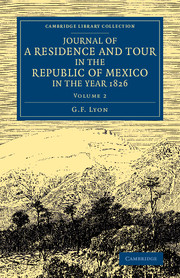Refine search
Actions for selected content:
26946 results in Economic history
Notes
-
- Book:
- Energy, Trade and Finance in Asia
- Published by:
- Pickering & Chatto
- Published online:
- 05 December 2014, pp 179-212
-
- Chapter
- Export citation
8 - Money or Export Commodity for Asia? American Silver in the Markets of Mexico, Castile and Amsterdam from the Sixteenth to the Eighteenth Century
-
-
- Book:
- Money in the Pre-Industrial World
- Published by:
- Pickering & Chatto
- Published online:
- 05 December 2014, pp 129-146
-
- Chapter
- Export citation
Introduction
-
- Book:
- Reforming the World Monetary System
- Published by:
- Pickering & Chatto
- Published online:
- 05 December 2014, pp 1-6
-
- Chapter
- Export citation
List of Abbreviations
-
- Book:
- Gambling on the American Dream
- Published by:
- Pickering & Chatto
- Published online:
- 05 December 2014, pp viii-viii
-
- Chapter
- Export citation
Notes
-
- Book:
- Female Economic Strategies in the Modern World
- Published by:
- Pickering & Chatto
- Published online:
- 05 December 2014, pp 161-194
-
- Chapter
- Export citation
CONTENTS
-
- Book:
- Federal Banking in Brazil
- Published by:
- Pickering & Chatto
- Published online:
- 05 December 2014, pp vii-viii
-
- Chapter
- Export citation
Notes
-
- Book:
- Mining and the State in Brazilian Development
- Published by:
- Pickering & Chatto
- Published online:
- 05 December 2014, pp 175-228
-
- Chapter
- Export citation
1 - The Marine Insurance Market for British Textile Exports to the River Plate and Chile, c. 1810–50
- from Part I - Non-Life Insurance
-
-
- Book:
- The Development of International Insurance
- Published by:
- Pickering & Chatto
- Published online:
- 05 December 2014, pp 25-36
-
- Chapter
- Export citation
2 - John Shaw in Business
-
- Book:
- Entrepreneurial Families
- Published by:
- Pickering & Chatto
- Published online:
- 05 December 2014, pp 23-40
-
- Chapter
- Export citation
Frontmatter
-
- Book:
- Multinationals, Subsidiaries and National Business Systems
- Published by:
- Pickering & Chatto
- Published online:
- 05 December 2014, pp i-iv
-
- Chapter
- Export citation
Works Cited and Sources
-
- Book:
- Multinationals, Subsidiaries and National Business Systems
- Published by:
- Pickering & Chatto
- Published online:
- 05 December 2014, pp 179-192
-
- Chapter
- Export citation
2 - Migration in the Urban Transition
-
- Book:
- Migrants and Urban Change
- Published by:
- Pickering & Chatto
- Published online:
- 05 December 2014, pp 35-68
-
- Chapter
- Export citation
1 - The Economic Origins of the Panic of 1819
-
- Book:
- Virginia and the Panic of 1819
- Published by:
- Pickering & Chatto
- Published online:
- 05 December 2014, pp 7-24
-
- Chapter
- Export citation
3 - John and Elizabeth in Love
-
- Book:
- Entrepreneurial Families
- Published by:
- Pickering & Chatto
- Published online:
- 05 December 2014, pp 41-58
-
- Chapter
- Export citation
5 - Vertical Integration and Trade Politics: Falconbridge's Success on World Markets in the 1930s
-
- Book:
- Multinationals, Subsidiaries and National Business Systems
- Published by:
- Pickering & Chatto
- Published online:
- 05 December 2014, pp 49-58
-
- Chapter
- Export citation
Introduction
-
- Book:
- Virginia and the Panic of 1819
- Published by:
- Pickering & Chatto
- Published online:
- 05 December 2014, pp 1-6
-
- Chapter
- Export citation

Journal of a Residence and Tour in the Republic of Mexico in the Year 1826
- With Some Account of the Mines of that Country
-
- Published online:
- 05 December 2014
- Print publication:
- 17 July 2014
- First published in:
- 1828

The Economies of Latin America
- New Cliometric Data
-
- Published by:
- Pickering & Chatto
- Published online:
- 05 December 2014
-
- Book
- Export citation
CONTENTS
-
- Book:
- Mining and the State in Brazilian Development
- Published by:
- Pickering & Chatto
- Published online:
- 05 December 2014, pp vii-vii
-
- Chapter
- Export citation
6 - Poor Relief
-
- Book:
- Virginia and the Panic of 1819
- Published by:
- Pickering & Chatto
- Published online:
- 05 December 2014, pp 103-136
-
- Chapter
- Export citation
